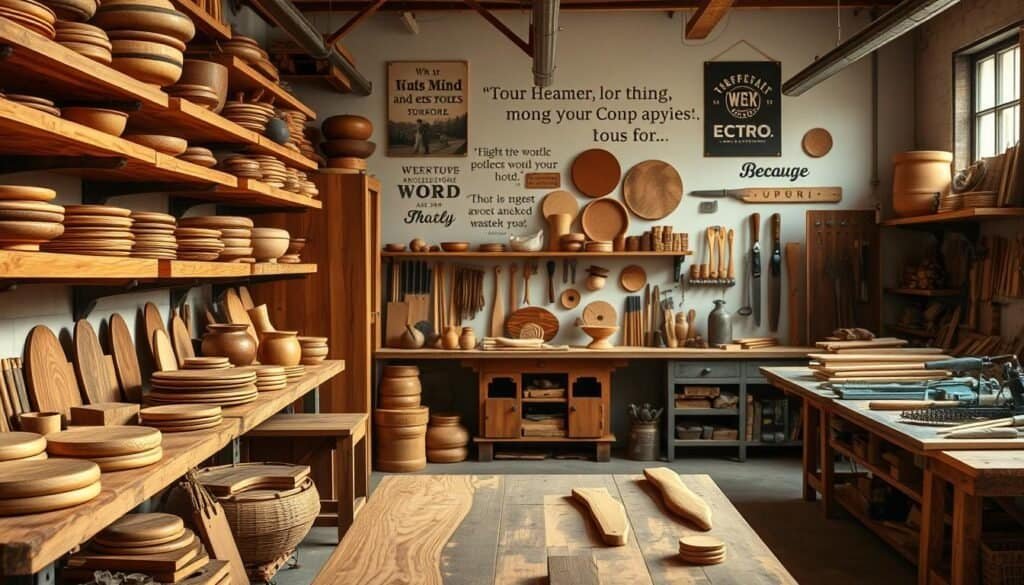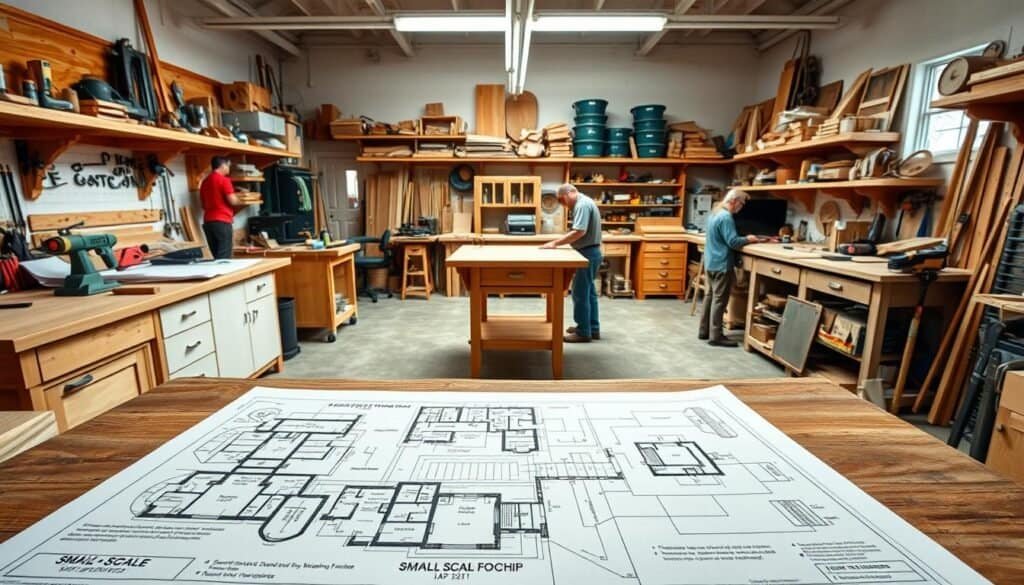Many dream of turning their passion into a career. For wood lovers, starting a woodworking business is a great idea.
With the right skills, woodworking can be very profitable. By making products people want, you can earn a good income. Plus, you get to enjoy working with your hands.
To do well in woodworking, you need a good business plan. This means knowing your market, keeping costs down, and marketing your work.
The Woodworking Industry: Market Overview and Market Overview and Market Overview and Market Overview and Market Overview and Market Overview and Market Overview and Market Overview and Market Overview and Market Overview and Market Overview and Market Overview and Market Overview and Market Overview and Market Overview and Market Overview and Market Overview and Market Overview and Market Overview and Market Overview and Market Overview and Market Overview and Market Overview and Market Overview and Market Overview and Market Overview and Market Overview and Market Overview and Market Overview and Market Overview and Market Overview and Market Overview and Market Overview and Market Overview and Market Overview and Market Overview and Market Overview and Market Overview and Market Overview and Market Overview and Market Overview and Market Overview and Market Overview and Market Overview and Market Overview and Market Overview and Market Overview and Market Overview and Market Overview and Market Overview and Market Overview and Market Overview and Market Overview and Market Overview and Market Overview and Market Overview and Market Overview and Market Overview and Market Overview and Market Overview and Market Overview and Market Overview and Market Overview and Market Overview and Market Overview and Market Overview and Market Overview and Market Overview and Market Overview and Market Overview and Market Overview and Market Overview and Market Overview and Market Overview and Market Overview and Market Overview and Market Overview and Market Overview and Market Overview and Market Overview and Market Overview and Market Overview and Market Overview and Market Overview and Market Overview and Market Overview and Market Overview and Market Overview and Market Overview and Market Overview and Market Overview and Market Overview and Market Overview and Market Overview and Market Overview and Market Overview and Market Overview and Market Overview and Market Overview and Market Overview and Market Overview and Market Overview and Market Overview and Market Overview and Market Overview and Market Overview and Market Overview and Market Overview and Market Overview and Market Overview and Market Overview and Market Overview and Market Overview and Market Overview and Market Overview and Market Overview and Market Overview and Market Overview and Market Overview and Market Overview and Market Overview and Market Overview and Market Overview and Market Overview and Market Overview and Market Overview and Market Overview and Market Overview and Market Overview and Market Overview and Market Overview and Market Overview and Market Overview and Market Overview and Market Overview and Market Overview and Market Overview and Market Overview and Market Overview and Market Overview and Market Overview and Market Overview and Market Overview and Market Overview and Market Overview and Market Overview and Market Overview and Market Overview and Market Overview and Market Overview and Market Overview and Market Overview and Market Overview and Market Overview and Market Overview and Market Overview and Market Overview and Market Overview and Market Overview and Market Overview and Market Overview and Market Overview and Market Overview and Market Overview and Market Overview and Market Overview and Market Overview and Market Overview and Market Overview and Market Overview and Market Overview and Market Overview and Market Overview and Market Overview and Market Overview and Market Overview and Market Overview and Market Overview and Market Overview and Market Overview and Market Overview and Market Overview and Market Overview and Market Overview and Market Overview and Market Overview and Market Overview and Market Overview and Market Overview and Market Overview and Market Overview and Market Overview and Market Overview and Market Overview and Market Overview and Market Overview and Market Overview and Market Overview and Market Overview and Market Overview and Market Overview and Market Overview and Market Overview and Market Overview and Market Overview and Market Overview and Market Overview and Market Overview and Market Overview and Market Overview and Market Overview and Market Overview and Market Overview and Market Overview and Market Overview and Market Overview and Market Overview and Market Overview and Market Overview and Market Overview and Market Overview and Market Overview and Market Overview and Market Overview and Market Overview and Market Overview and Market Overview and Market Overview and Market Overview and Market Overview and Market Overview and Market Overview and Market Overview and Market Overview and Market Overview and Market Overview and Market Overview and Market Overview and Market Overview and Market Overview and Market Overview and Market Overview and Market Overview and Market Overview and Market Overview and Market Overview and Market Overview and Market Overview and Market Overview and Market Overview and Market Overview and Market Overview and Market Overview and Market Overview and Market Overview and Market Overview and Market Overview and Market Overview and Market Overview and Market Overview and Market Overview and Market Overview and Market Overview and Market Overview and
Can Woodworking Really Become a Profitable Business? Real Numbers and Facts
Many woodworking fans wonder if their hobby can turn into a money-making business. The key is to know the market, find good business ideas, and do them well.
Woodworking pros show that making money is possible. For example, making plans for DIY projects or home decor can draw lots of customers.

To succeed, find a niche that people want. Specializing in custom furniture or wood carvings can make you stand out and get paid well.
Also, selling online can reach more people. Use e-commerce sites or social media to show off your work and sell more.
Studies of successful woodworking businesses show that quality, marketing, and smart pricing are key. Sales or discounts can bring in new customers and keep old ones coming back.
Woodworking businesses must also watch their costs. This includes the cost of materials, tools, and labor. Making things efficiently and reducing waste can help make more money.
In short, with the right approach and focus on quality and customer happiness, woodworking can be a profitable business. Knowing the market and using smart business ideas can turn a hobby into a lasting business.
Essential Skills and Knowledge for a Successful Woodworking Business
To succeed in woodworking, you need to know both the craft and the market. Woodworking entrepreneurs must have technical skills, business knowledge, and marketing savvy.
Technical skills are key to making quality woodworking products. Knowing how to use  woodworking tools and understanding different woods is essential. Beginners can start with simple projects and get better over time.
woodworking tools and understanding different woods is essential. Beginners can start with simple projects and get better over time.
But there’s more to it than just making things. Running a business means managing money, setting prices, and dealing with clients. You also need to know how to market and sell your products.
Keeping up with woodworking trends and knowing what customers want is also important. Joining workshops and learning from others can help improve your skills.
In short, a successful woodworking business needs quality work, smart business moves, and good marketing. By focusing on these areas, entrepreneurs can build a thriving business.
Investment Requirements: Tools, Workshop, and Materials
To make woodworking a profitable business, you need to invest in tools, a workshop, and materials. The cost for quality tools and a good workshop can be high.
Getting the best woodworking tools is key for making top-notch products. Starting with basic tools and DIY solutions is possible. But, a professional setup requires a bigger investment. You’ll need table saws, sanders, and drills.

Choosing sustainable materials is good for the planet and can save money. Using sustainable wood like reclaimed or local timber adds value. It also attracts eco-friendly customers, making your products stand out.
Alternative Materials for Profit Maximization
Looking into alternative materials can boost profits. For example, making pallet furniture outdoor uses materials that would be thrown away. Also, turning old wood into garage storage is both green and profitable.
Having a well-organized workshop setup is essential. It means arranging your space for better work and getting storage for your tools and materials.
By planning your investments wisely, you can start a woodworking business that’s both profitable and eco-friendly.
Finding Your Woodworking Niche: Most Profitable Specializations
Choosing the right woodworking specialization can change your business game. It’s key to pick a niche that fits your skills and what people want. This way, you can stand out in a crowded market.
Custom furniture making is a top choice for making money. More people want unique, handmade furniture for their homes. Using free woodworking plans can help you start making custom pieces that many customers will love.

Wood diy projects, like wooden decor and shelving, are also very profitable. Homeowners love adding personal touches to their homes with these items. Outdoor furniture and garden decor from carpentry diy projects also have a big market.
Creating functional items like cutting boards and kitchen utensils is in demand too. These items are useful and make great gifts. This can help you reach more customers.
To make more money, look for free or low-cost woodworking plans. These can inspire and guide you as you make your products. By focusing on a niche and getting better at your craft, you can build a successful woodworking business.
Pricing Strategies That Maximize Profit Without Scaring Customers
To stay competitive, woodworking businesses must find the right balance. They need to make a profit without losing customers. This balance requires knowing costs, market conditions, and what customers expect.
Figuring out the right price starts with knowing your costs. This includes materials, labor, and overheads. For example, making custom furniture means considering wood costs, labor, and extra features like carvings.

Understanding the market is also key. Look at what other woodworking businesses charge. This helps set prices that are competitive and meet customer expectations.
Competitive pricing isn’t just about being cheap. It’s about providing value. Show off the quality of your tools, the precision of your cutters, and the uniqueness of your designs. This can justify higher prices.
Think about the psychology of pricing too. Using charm pricing, like ending prices in .99, can make things seem cheaper. Being open about your pricing can also build trust with customers.
By analyzing costs, understanding the market, and using smart pricing, you can increase profits. This way, your woodworking business can grow and stay sustainable.
Building Your Brand: Marketing Your Woodworking Business
In woodworking, a strong brand can turn a hobby into a business. Good branding and marketing are key for woodworking entrepreneurs. They help reach new customers and build a loyal fan base.
Social Media Platforms for Woodworking Businesses
Social media is a great tool for woodworking businesses. Sites like Instagram and Pinterest are perfect for sharing product images and videos. They let businesses show off their work to a wide audience.
Using social media, businesses can share what goes on behind the scenes. This shows off their skills and product quality. Talking to followers builds a strong community around the brand.

Content marketing is also a smart move. Creating tutorials, blog posts, and videos teaches viewers new things. This makes the business seem like an expert in woodworking.
Woodworking tutorials are very engaging. They teach viewers new skills, which is valuable. Sharing knowledge through content marketing builds trust and subtly promotes products.
By mixing social media and content marketing, woodworking businesses can grow. This approach helps turn a hobby into a lasting business.
Selling Platforms: From Craft Fairs to E-commerce
Woodworking entrepreneurs have many ways to sell their products. They can choose from craft fairs to online stores. Knowing the good and bad of each option is key to success.
Craft fairs let artisans meet customers face-to-face. They can show their products in real life. But, they take a lot of time and money for booths and stock.

E-commerce sites, on the other hand, let businesses sell worldwide. They need a strong online presence with good photos and descriptions. This helps attract more customers.
Online sales need good logistics and shipping. This ensures products arrive on time. Showing off woodworking plans and quality tools like jigsaw saws can make products more appealing.
For those using materials like aluminum extrusion, stressing product durability and quality is important. This can attract more buyers.
Combining old and new sales methods can help woodworking businesses grow. This mix can increase their reach and profits.
Client Management and Building a Loyal Customer Base
A woodworking business is only truly successful with a loyal customer base. It needs effective client management strategies. It’s not just about finishing projects; it’s about building lasting relationships.
Customer service is key in client management. It means answering customer questions quickly, delivering on time, and doing high-quality work. Using tools like a plunge router or router machine can improve work quality, making customers happier.

To build loyalty, keep in touch with customers. Send updates during a project and check in after it’s done. This makes customers feel important and valued. It also encourages them to share good experiences with others, helping your business grow.
By focusing on client management and loyalty, woodworking businesses can thrive. These strategies take dedication and a focus on the customer. But the rewards are huge.
Success Stories: Woodworkers Who Built Profitable Businesses
The world of woodworking is full of success stories. People have turned their passion into profitable businesses. They have made thriving careers out of carpentry and DIY projects.

A craftsman started with basic tools, like an electric planer. They built a reputation for custom furniture. By using online platforms and local fairs, they grew their customer base and profits.
Another woodworker focused on woodturning and created a brand. They made unique, handmade items. Good marketing and quality products helped them stand out in the competitive industry.
These stories show the power of turning passion into profit. Quality, the right tools, and smart marketing are key. Many woodworkers have found great success this way.
Scaling Your Woodworking Business: From Solo Artisan to Small Workshop
Going from a solo artisan to running a small workshop is a big step. You’ll need to think about several important things to make the transition smooth.
First, plan how to expand your workshop. Look at your current space and figure out how to make it better for more work. You might need new tools, like homemade ones, to work faster.

Scaling up also means thinking about hiring people. The right team can handle more work, but finding them takes planning. You’ll need to teach them your skills and make sure they meet your quality standards.
Managing your money well is key when you grow. Your costs will go up, so watch your spending closely. This includes the cost of materials, tools, and staff.
To keep your business growing, focus on keeping your products top-notch. Set up quality checks and make sure your team follows your standards.
With good planning for your workshop, team, and finances, you can grow your woodworking business. It will go from a solo effort to a successful small workshop.
Legal Considerations for Woodworking Businesses
Starting a woodworking business means dealing with many legal steps. It’s key to know these to make your business successful and last long.
First, you must register your business. This includes picking a name, registering with the state, and getting a federal tax ID number. Registering makes your business official and can help with taxes.

Next, you need the right licenses and permits. These vary based on where you are and what your business does. For example, you might need a sales tax permit if you sell directly to customers. You might also need zoning permits to run your business from home or a specific place.
Creating a detailed business plan that covers these legal points can make things easier. It’s smart to talk to a lawyer too. They can help make sure you’re following all the rules.
In short, the legal side of starting a woodworking business might look tough. But it’s essential for a real and thriving business. By following these rules, you can grow your business with confidence.
Financial Management for Woodworking Entrepreneurs
To make your woodworking hobby profitable, you need to master financial management. This means learning about budgeting, controlling costs, and making more money.
Start by making a detailed budget. It should cover all costs like tools, materials, rent, and marketing. Knowing the difference between fixed and variable costs helps you make smart business choices.

Controlling costs is key. Save money by making your own tools and finding cheaper suppliers. Regularly check your suppliers to get better deals.
Setting the right prices is also important. You want to be competitive but also make enough profit. Knowing your market and what you offer helps set good prices.
With these financial tips, woodworking businesses can thrive and stay profitable over time.
Conclusion: Turning Your Woodworking Passion into a Sustainable Business
Turning your woodworking passion into a business takes careful planning and a willingness to adapt. You need to understand the woodworking industry and find a profitable niche. Developing essential skills is also key to creating a sustainable business that makes consistent money.
A successful woodworking business relies on quality products, effective marketing, and strong client relationships. Using the right selling platforms and managing finances well are important. Scaling your business strategically can lead to long-term success and make your woodworking passion a fulfilling career.
With the right mindset and a solid plan, you can make your woodworking passion into a profitable business. Start by taking the first step today. Watch your woodworking business grow into a profitable venture that brings you financial rewards and personal satisfaction.
FAQ
Q: What are the initial investments required to start a woodworking business?
A: Starting a woodworking business requires a lot of money. You need tools like table saws and a workspace. Costs can be from a few thousand to tens of thousands of dollars.Q: How do I choose the right woodworking niche for my business?
A: Pick a niche by looking at market demand and your skills. Focus on areas like pallet furniture or custom cabinetry. Research trends to find a profitable niche.Q: What pricing strategies are effective for woodworking businesses?
A: Good pricing strategies include cost-plus and value-based pricing. Understand your costs and what customers are willing to pay. This helps you make a profit without losing customers.Q: How can I market my woodworking business effectively?
A: Use social media, content marketing, and local events to market your business. Share tutorials and stories to attract and keep customers.Q: What are the legal considerations for starting a woodworking business?
A: You need to register your business and get licenses. Follow local laws and understand taxes and employment laws. This keeps your business legal and compliant.Q: How can I scale my woodworking business from a solo operation to a small workshop?
A: Scaling up means planning and investing in more equipment. Hire staff and adjust your workflow to grow. This helps you handle more work efficiently.Q: What financial management strategies are critical for a woodworking business?
A: Manage your finances by budgeting and controlling costs. Review your finances often and adjust as needed. Invest in tools that improve efficiency and reduce waste.Q: Can I make a profit from selling wooden products online?
A: Yes, selling online can be profitable. Choose the right products, price them well, and market them online. Know your audience and optimize your online presence.Q: What are some profitable woodworking projects for beginners?
A: Beginners can start with simple projects like pallet furniture or small decor items. These projects are easy and can be sold online or locally.Q: How do I source sustainable wood for my woodworking business?
A: Find sustainable wood by looking for responsible suppliers. Use reclaimed wood or alternative materials. Consider FSC certification to ensure sustainability.

 woodworking tools and understanding different woods is essential. Beginners can start with simple projects and get better over time.
woodworking tools and understanding different woods is essential. Beginners can start with simple projects and get better over time.












